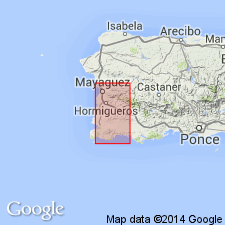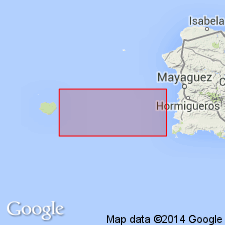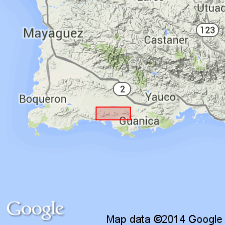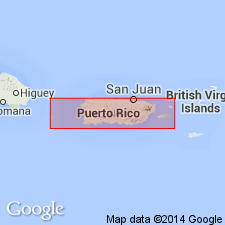
- Usage in publication:
-
- Bermeja complex
- Modifications:
-
- Named
- Dominant lithology:
-
- Serpentinite
- Volcanics
- Amphibolite
- AAPG geologic province:
-
- Caribbean region
Summary:
Bermeja complex named in southwestern PR. Consists of serpentinite, silicified porphyritic volcanics, and fine-grained silicified sediments or volcanics, with minor spilite, amphibolitized spilite, and amphibolite. Diorite plug intrudes the complex. Oldest rocks in area; exposed only in some anticlinal cores. Unconformably overlain by a sequence of shallow-water sediments and extrusive and pyroclastic volcanics, Cretaceous to Eocene in age. In most parts of the area, lava flows (the Rio Loco formation) are at the base of that sequence. Where the Rio Loco is absent, complex underlies the Mayaguez group (new). Age is unknown, but age determinations in basal Mayaguez rocks resting unconformably on serpentinite show that Bermeja complex is older than Santonian-Campanian and possibly older than Cenomanian.
Source: GNU records (USGS DDS-6; Reston GNULEX).

- Usage in publication:
-
- Bermeja complex
- Modifications:
-
- Overview
- AAPG geologic province:
-
- Caribbean region
Summary:
Mattson applied term Bermeja complex to basement rocks which include amphibolite, serpentinites, and metamorphosed cherts. In present report, term deformed sequence is applied to the folded, faulted, intruded, but unmetamorphosed rocks that rest unconformably on the Bermeja complex. The Bermeja crops out only in southwestern PR. Here it is overlain unconformably by the Rio Loco formation, oldest unit of the deformed sequence. In Barranquitas quad in south-central PR, the Rio Loco underlies a formation containing fossils of Cenomanian-Turonian age. Bermeja complex, therefore, must be Cenomanian or older in age.
Source: GNU records (USGS DDS-6; Reston GNULEX).

- Usage in publication:
-
- Bermeja Complex
- Modifications:
-
- Overview
Summary:
Units assigned to Bermeja Complex are, from oldest: serpentinized peridotite, Las Palmas Hornblende Schist and Amphibolite, Mariquita Chert, Cajul Volcanic Rocks, and Maguayo Porphyry. Age is Early(?) Cretaceous.
Source: GNU records (USGS DDS-6; Reston GNULEX).

- Usage in publication:
-
- Bermeja Complex
- Modifications:
-
- Age modified
- Overview
- AAPG geologic province:
-
- Caribbean region
Summary:
The basaltic rocks of the Bermeja Complex range in metamorphic grade from weakly metamorphosed prehnite-bearing rocks, through greenstones, to amphibolites. Data suggests an ocean floor origin for the higher grade metamorphic rocks, whereas the lower grade metamorphics may have originated in an island arc setting. The Bermeja includes the oldest dated rocks on the island, which are Late Jurassic amphibolites. Previous workers have interpreted the complex as a dismembered ophiolite complex. Mattson (1960, 1964) distinguished four rock types: serpentinized peridotite, spilite (here named the Las Mesas Greenstone), amphibolite (later named the Las Palmas Hornblende Schist and Amphibolite, and silicified volcanic rock and (or) chert (later named the Mariquita Chert. In southwest PR, north and south of the Valle de Lajas, the Bermeja disconformably underlies the volcanic rocks of the Boqueron Basalt and the Lajas Formation and locally conformably underlies the Cotui Limestone. Intruded by the Maguayo Porphyry.
Source: GNU records (USGS DDS-6; Reston GNULEX).
For more information, please contact Nancy Stamm, Geologic Names Committee Secretary.
Asterisk (*) indicates published by U.S. Geological Survey authors.
"No current usage" (†) implies that a name has been abandoned or has fallen into disuse. Former usage and, if known, replacement name given in parentheses ( ).
Slash (/) indicates name conflicts with nomenclatural guidelines (CSN, 1933; ACSN, 1961, 1970; NACSN, 1983, 2005, 2021). May be explained within brackets ([ ]).

